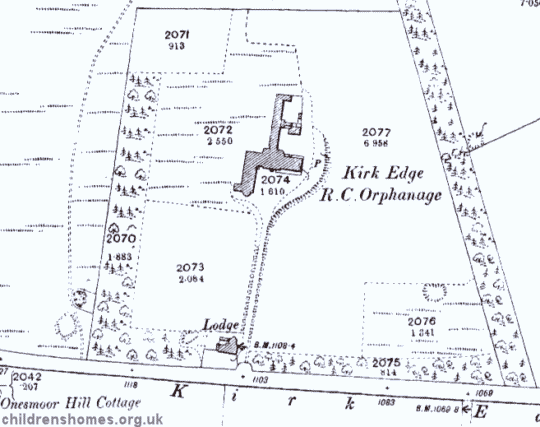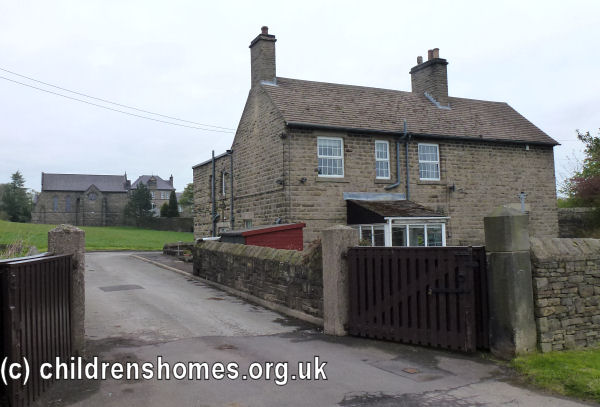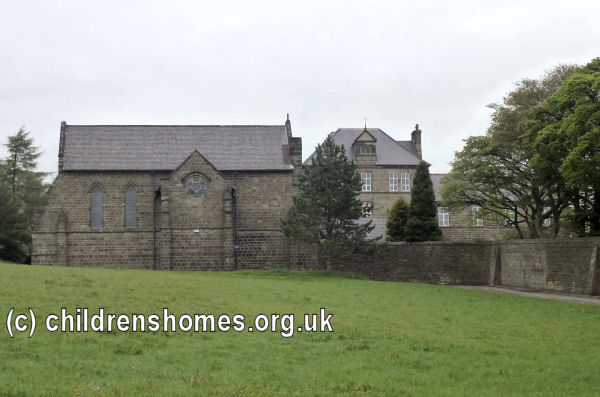Kirkedge Orphanage / Industrial School / Reformatory, near Sheffield, West Riding of Yorkshire
An orphanage for Roman Catholic children was erected in 1871-2 at Kirkedge (or Kirk Edge), Bradfield, to the north-west of Sheffield. The Duke of Norfolk gave 189 acres of land for the institution which was run by the Sisters of Charity of St. Vincent de Paul. The building work took longer than expected and 40 children who were destined for the orphanage had to be placed in temporary accommodation at Hollis Croft on Broad Lane, Sheffield.
On November 16th, 1875, the premises were certified for use as an Industrial School to receive girls placed by the courts for reasons such as vagrancy or being in moral danger. Voluntary cases were also accepted. An inspection report in 1878 was very positive about the establishment, noting that there had been no punishment and that the girls were treated with great kindness and tact. By the following year, a large new wing had been added to the building. It included a large schoolroom, with a refectory underneath, and a room above to be used either as a dormitory or a chapel. A new gatehouse had also been erected.
The Kirkedge site is shown on the 1893 map below.

Kirkedge Orphanage site, c.1893.
By 1880, the average number of inmates was 70. They assisted in the housework and laundry, and were taught sewing and knitting etc. with a view to entering domestic service. All the girls' clothing and stockings were made on the premises. The Superintendent at this date was Sister Agnes Crangle, assisted by five Sisters of the Order.
Another new wing was opened in 1884 on the west side of the building, providing some shelter against the prevailing wind in what was regularly noted as the School's bleak and exposed location. The ground floor housed a chapel measuring 80 feet by 26 feet, with the Sisters' community room adjoining it, and dormitories and an infirmary above. The extension, like the original building, was designed by Messrs. M. E. Hadfield and Son, and constructed by Messrs. Tomlinson and Sons, of Leeds and Sheffield, at a cost of about £2,500.
In 1885, the average number of inmate was 100. It was noted that about 25 acres of the moorland belonging to the School had now been reclaimed and that five cows were being kept.
In 1887, largely because of its remote location and water supply problems, the School resigned its certificate. At the same time, the St Joseph's Reformatory for Roman Catholic Girls at Howard Hill, Sheffield, was closed because of declining admissions. The St Joseph's site was then re-opened as the St Joseph's Industrial School for Roman Catholic Girls, taking the existing inmates from Kirkedge. The Sisters of Charity moved out and the property was left empty.
After its closure, the property had occasional used as a holiday home for poor Catholic boys from Sheffield. Proposals to allow its use as an isolation hospital were rejected, however.
Following a disastrous fire on board the Reformatory Ship Clarence in July, 1899, the 120 or so inmates were housed for a period in Liverpool and then at St David's College, near Mold, North Wales. In 1901, they transferred to the Kirkedge premises which were temporarily certified for use as a Reformatory on September 3rd of that year. The certificate was terminated on November 10th, 1905, with the boys moving to occupy the new land-based St Aidan's Nautical School at Farnworth, near Widnes.

Former Kirkedge Orphanage entrance from the south, Sheffield, c.2013. © Peter Higginbotham

Former Kirkedge Orphanage from the south, Sheffield, c.2013. © Peter Higginbotham
In 1910, following a suggestion by his sister who was a Carmelite nun, the Duke of Norfolk presented the Orphanage premises to the Catholic Church for use as a Carmelite convent. Around £10,000 was spent on restoring and adapting the building and on July 16th, 1911, it was officially opened by Cardinal Bourne. Originally called the Convent of the Holy Ghost, it is today known as the Monastery of the Holy Spirit.
Records
Note: many repositories impose a closure period of up to 100 years for records identifying individuals. Before travelling a long distance, always check that the records you want to consult will be available.
- Sheffield Archives, 52 Shoreham Street, Sheffield S1 4SP. Has a folder containing accounts and correspondence relating to Kirkedge Orphanage; Cash book (1870-97); Architect's drawing by M.E. Hadfield & Son (undated).
Census
Bibliography
- Carpenter, Mary Reformatory Schools, for the Children of the Perishing and Dangerous Classes, and for Juvenile Offenders (1851, General Books; various reprints available)
- Carlebach, Julius Caring for Children in Trouble (1970, Routledge & Kegan Paul)
- Higginbotham, Peter Children's Homes: A History of Institutional Care for Britain's Young (2017, Pen & Sword)
- Abel Smith, Doroth Crouchfield: A History of the Herts Training School 1857-1982 (2008, Able Publishing)
- Garnett, Emmeline Juvenile offenders in Victorian Lancashire: W J Garnnett and the Bleasdale Reformatory (2008, Regional Heritage Centre, Lancaster University)
- Hicks, J.D. The Yorkshire Catholic Reformatory, Market Weighton (1996, East Yorkshire Local History Society)
- Slocombe, Ivor Wiltshire Reformatory for Boys, Warminster, 1856-1924 (2005, Hobnob Press)
- Duckworth, J.S. The Hardwicke Reformatory School, Gloucestershire (in Transactions of the Bristol and Gloucestershire Archaeological Society, 1995, Vol. 113, 151-165)
Links
- Daughters of Charity (British Province)
- Kirk Edge Carmelite Monastery
- Red Lodge Museum, Bristol — a former girls' reformatory.
Except where indicated, this page () © Peter Higginbotham. Contents may not be reproduced without permission.


